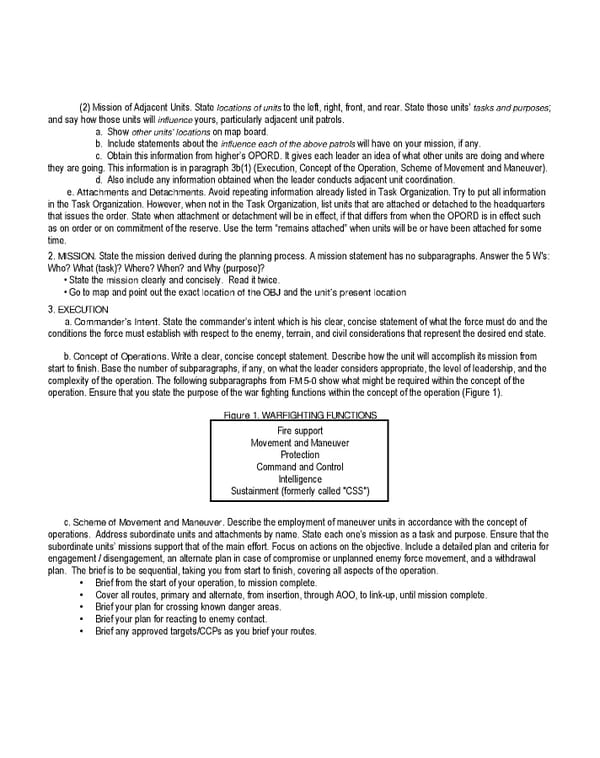(2) Mission of Adjacent Units. State locations of units to the left, right, front, and rear. State those units’ tasks and purposes; and say how those units will influence yours, particularly adjacent unit patrols. a. Show other units’ locations on map board. b. Include statements about the influence each of the above patrols will have on your mission, if any. c. Obtain this information from higher’s OPORD. It gives each leader an idea of what other units are doing and where they are going. This information is in paragraph 3b(1) (Execution, Concept of the Operation, Scheme of Movement and Maneuver). d. Also include any information obtained when the leader conducts adjacent unit coordination. e. Attachments and Detachments. Avoid repeating information already listed in Task Organization. Try to put all information in the Task Organization. However, when not in the Task Organization, list units that are attached or detached to the headquarters that issues the order. State when attachment or detachment will be in effect, if that differs from when the OPORD is in effect such as on order or on commitment of the reserve. Use the term “remains attached” when units will be or have been attached for some time. 2. MISSION. State the mission derived during the planning process. A mission statement has no subparagraphs. Answer the 5 W's: Who? What (task)? Where? When? and Why (purpose)? • State the mission clearly and concisely. Read it twice. • Go to map and point out the exact location of the OBJ and the unit’s present location 3. EXECUTION a. Commander’s Intent. State the commander’s intent which is his clear, concise statement of what the force must do and the conditions the force must establish with respect to the enemy, terrain, and civil considerations that represent the desired end state. b. Concept of Operations. Write a clear, concise concept statement. Describe how the unit will accomplish its mission from start to finish. Base the number of subparagraphs, if any, on what the leader considers appropriate, the level of leadership, and the complexity of the operation. The following subparagraphs from FM 5-0 show what might be required within the concept of the operation. Ensure that you state the purpose of the war fighting functions within the concept of the operation (Figure 1). Figure 1. WARFIGHTING FUNCTIONS Fire support Movement and Maneuver Protection Command and Control Intelligence Sustainment (formerly called "CSS") c. Scheme of Movement and Maneuver. Describe the employment of maneuver units in accordance with the concept of operations. Address subordinate units and attachments by name. State each one’s mission as a task and purpose. Ensure that the subordinate units’ missions support that of the main effort. Focus on actions on the objective. Include a detailed plan and criteria for engagement / disengagement, an alternate plan in case of compromise or unplanned enemy force movement, and a withdrawal plan. The brief is to be sequential, taking you from start to finish, covering all aspects of the operation. • Brief from the start of your operation, to mission complete. • Cover all routes, primary and alternate, from insertion, through AOO, to link-up, until mission complete. • Brief your plan for crossing known danger areas. • Brief your plan for reacting to enemy contact. • Brief any approved targets/CCPs as you brief your routes.
 Ranger Handbook Page 33 Page 35
Ranger Handbook Page 33 Page 35